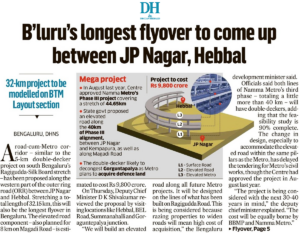Published on: February 7, 2025
BENGALURU’S MEGA INFRASTRUCTURE PROJECT
BENGALURU’S MEGA INFRASTRUCTURE PROJECT
NEWS – B’luru’s longest flyover to come up between JP Nagar, Hebbal. 32-km project to be modelled on BTM Layout section
HIGHLIGHTS:
- Project Scope: A proposed 32.15 km road-cum-Metro corridor along the western part of the Outer Ring Road (ORR) between JP Nagar and Hebbal.
- Model: Inspired by the successful 5-km double-decker project on Ragigudda-Silk Board stretch in South Bengaluru.
- Features:
- Elevated road component for 8 km on Magadi Road.
- Double-decker Metro lines for both lines of Phase III.
- Integration of road and Metro infrastructure on the same pillars.
- Estimated Cost: Rs. 9,800 crore, to be shared equally by BBMP and Namma Metro.
- Benefits:
- Ease traffic congestion on the ORR, particularly at Goraguntepalya junction.
- Create a signal-free corridor between Dr. Rajkumar Memorial and BEL Circle.
- Improve connectivity and reduce travel time.
- Long-term vision: Designed to accommodate future traffic growth for the next 30-40 years.
Challenges and Considerations:
- Delay in Tendering: Changes in design, particularly to accommodate the double-decker concept, have delayed the tendering process for Metro’s civil works.
- Land Acquisition: Acquisition of properties belonging to the Defence Ministry and CMTI will be crucial for the project’s implementation.
- Cost Implications: The project’s high cost necessitates careful financial planning and resource allocation.
- Public Impact: Potential inconvenience to Metro passengers during construction and implementation phases.

